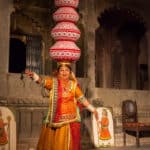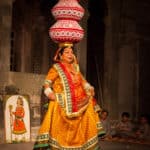Bhavai dance is a Rajasthani folk dance from northern India which involves the use of “earthen or brass pitchers” known as Bhavai. This popular “folk dance” has originated from the state of Rajasthan which is located on the western coast of the country. Furthermore, this dance form essentially comprises of male and female performers dancing fluidly while balancing about seven to nine pitchers made up of mainly brass. In addition, the female performers use a “veil” to cover up the face during the performance. The first official “Bhavai dancer” in India was, Mrs Krishna Vyas Chhangani belonging to Jodhpur also commonly known as “Sun City”.
A. History/origin of the Bhavai Dance:
According to the cultural history of Rajasthan, this dance style has been developed mainly by woman belonging to communities such as Bhil, Meena, Jat, Kumbhar, Kalbelia, and Raiger over a period of time. Apparently, the technique of this style of dancing was created using the image of women carrying water pots on their heads in the desert over large distances as a template. Furthermore, it is also said that the Bhavai was actually first founded in Gujarat and was then modified further in Rajasthan.
b. Costume used in the Bhavai Dance:
The costume used by females in this dance form includes a long Rajasthani skirt called Ghagra along with a choli which has been embroidered using beautiful mirror work. In addition, the costume also includes beautiful jewellery as well as bangles worn on the wrist. As for men the attire used includes, a dhoti kurta, a colourful sleeveless jacket, and a “kamarbandh” (i.e. a form of a belt) which is essentially tied around the waist.
c. Music used in the Bhavai Dance:
The music is composed usually by males for this dance form. The musical instruments used to produce music for this dance includes the Jhanjhar, Dholak, harmonium, sarangi, and pakhwaj. In addition, the use of typical “Rajasthani folk lyrics” adds more charm and beauty to the music used during a “Bhavai” performance.
d. Training availability and dance technique involved in the Bhavai Dance:
The technique related this dance form essentially involves a performer (mostly females) dancing using rapid spinning movements to the beats of folk music, while simultaneously balancing about seven to nine brass water pitchers on the head. In addition, an extremely courageous dancer may even chose to stand upon a sword or broken glass while performing. In terms of training facilities, there are not many specific training centres/schools available for those interested in learning this dance, since it has not become popular like folk dances such as bhangra or garba.





